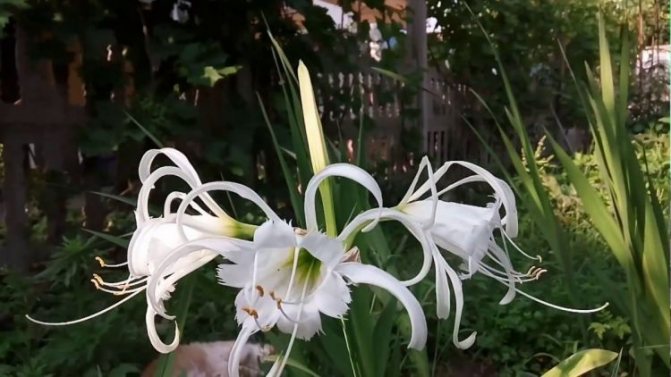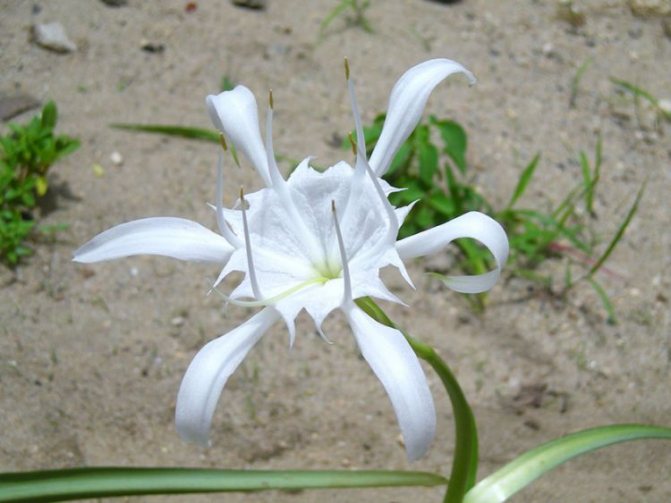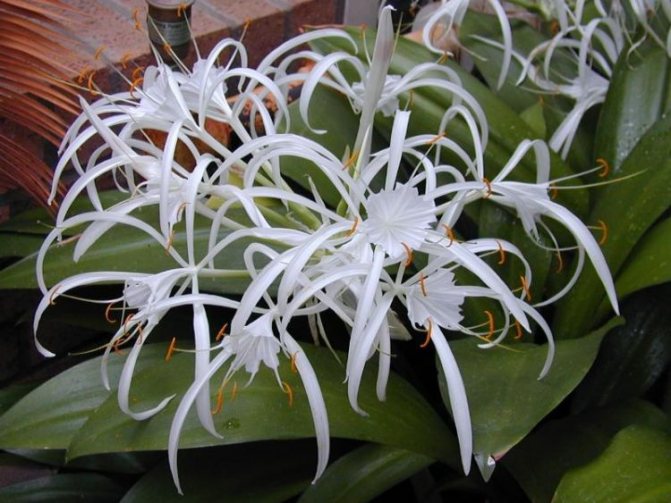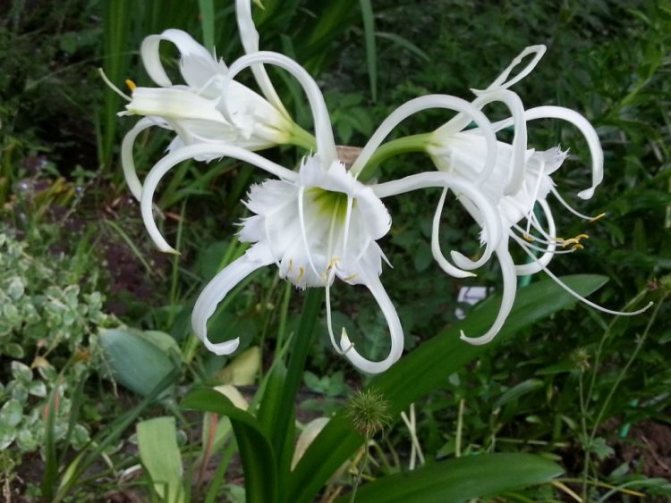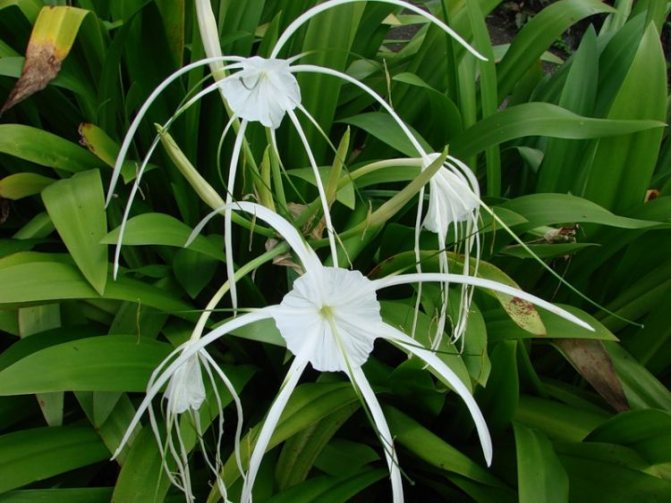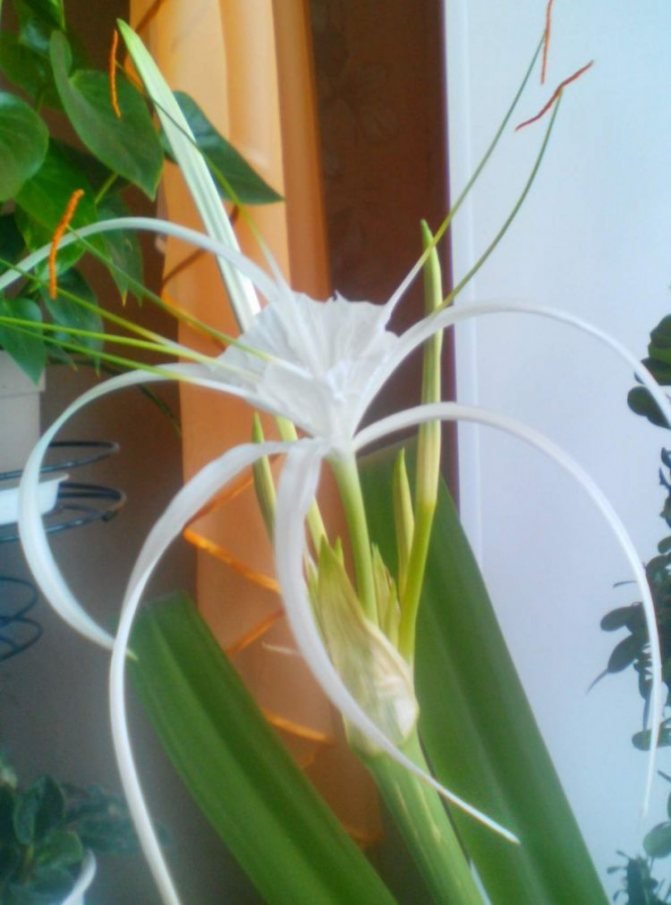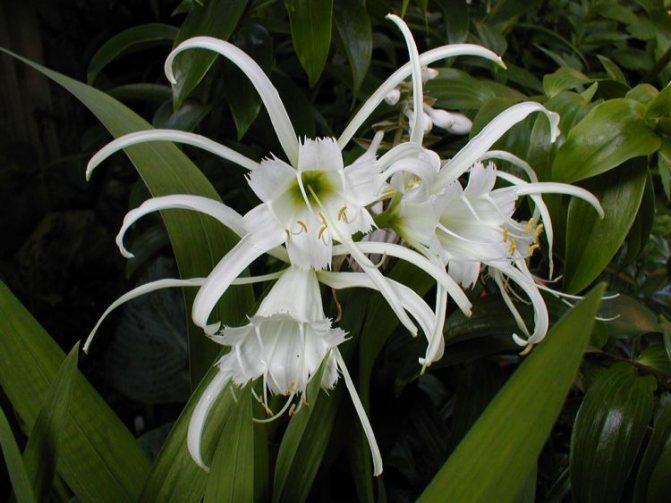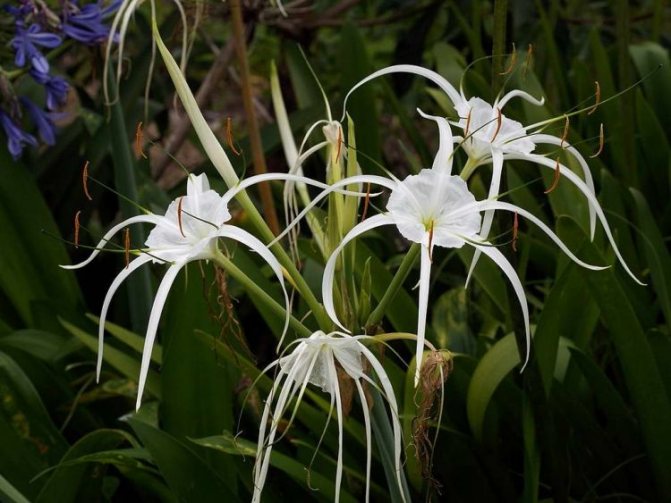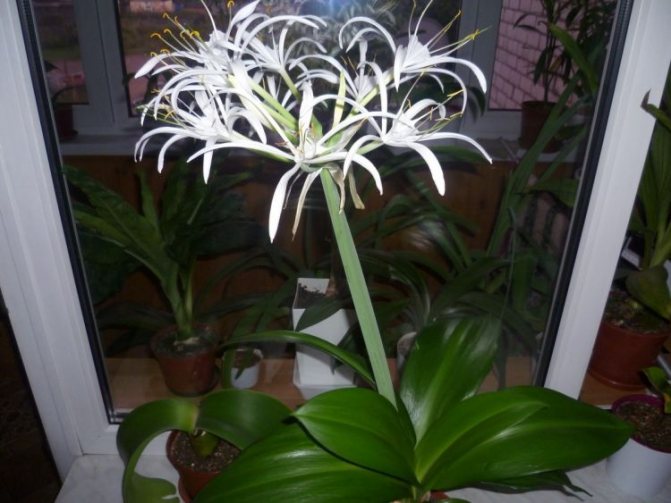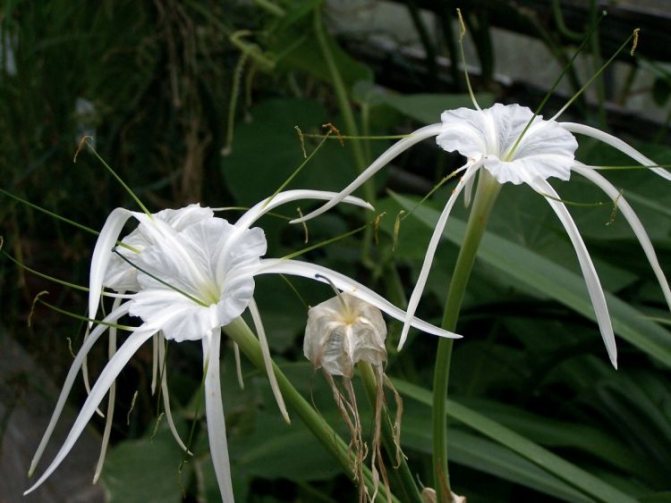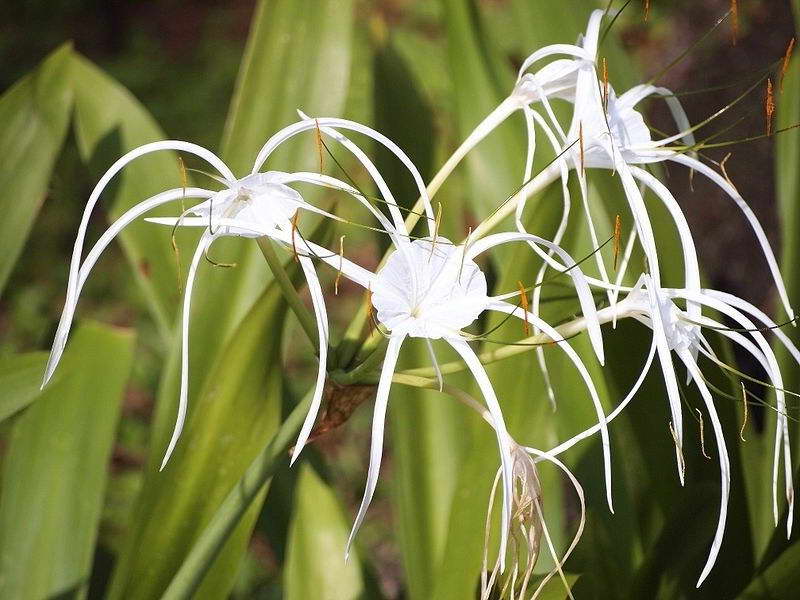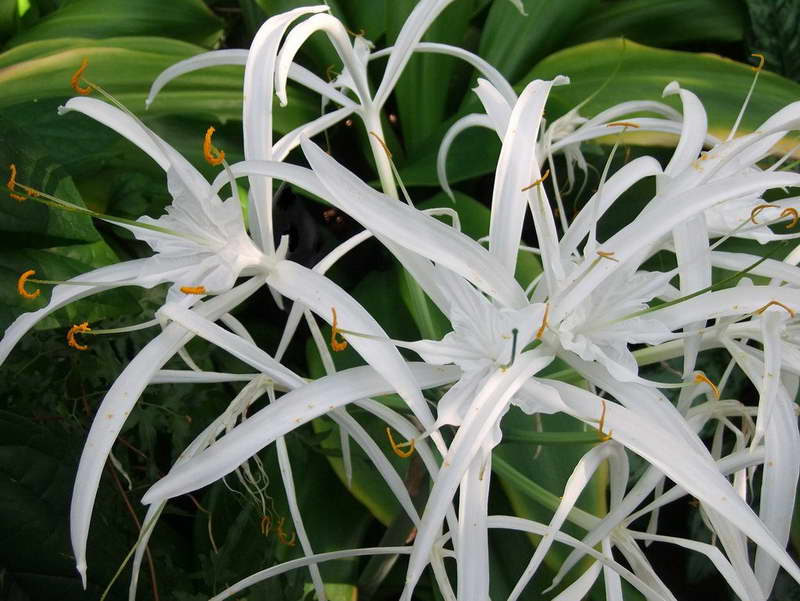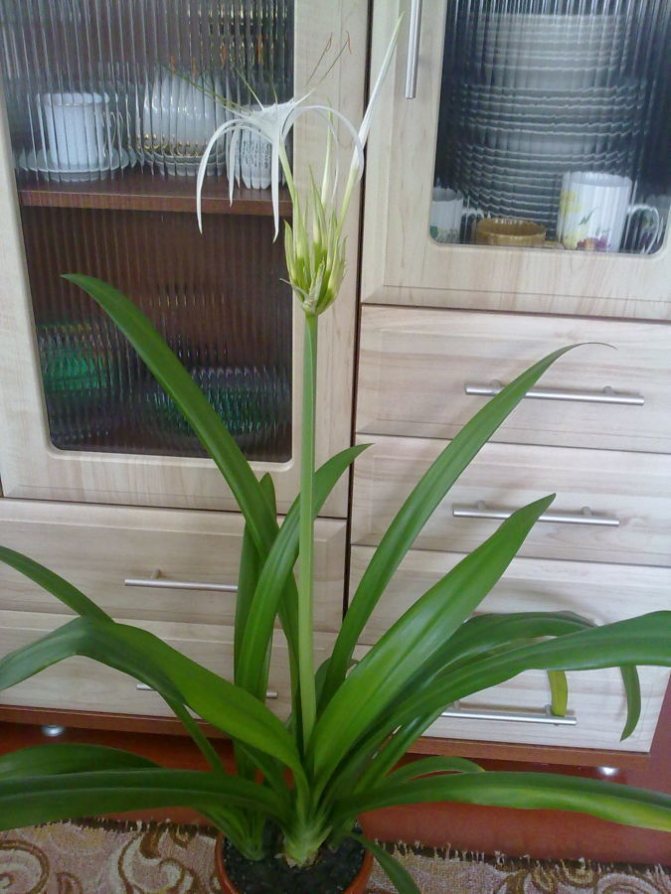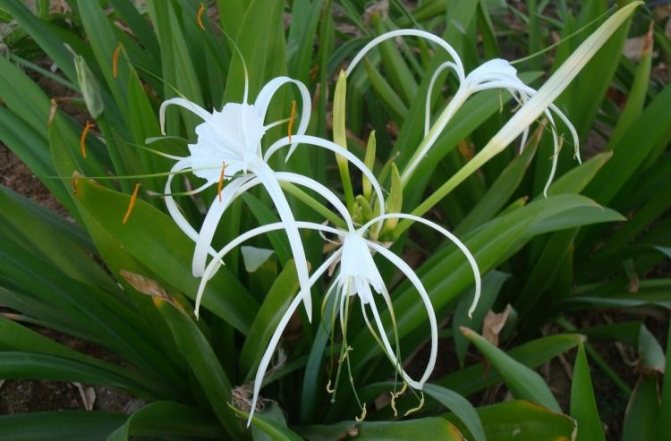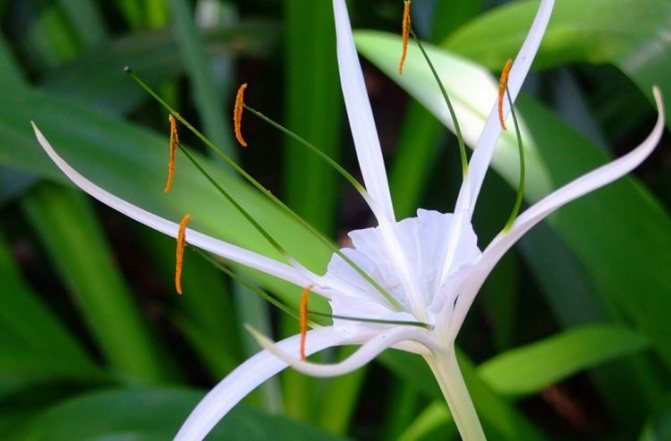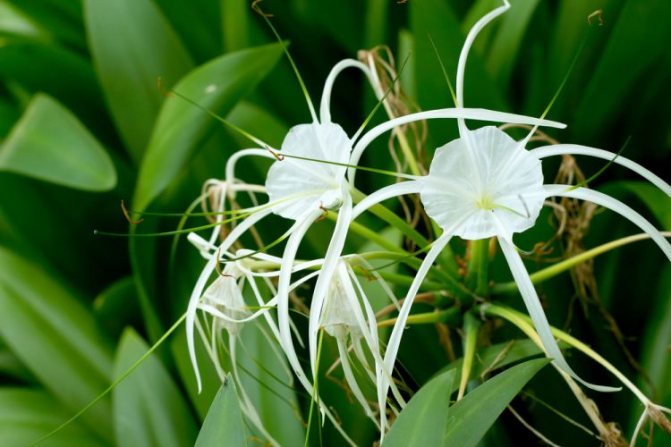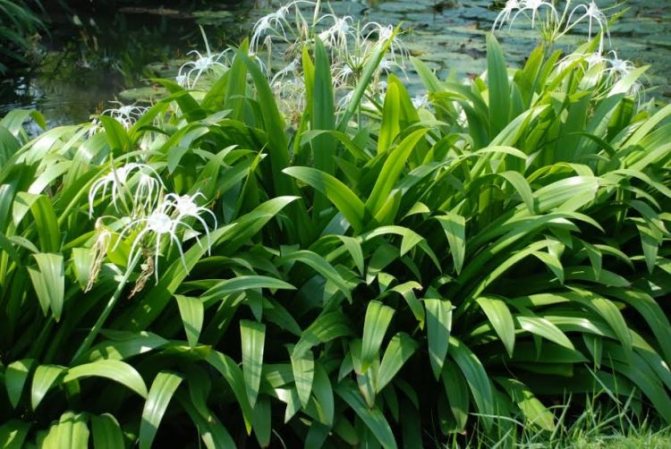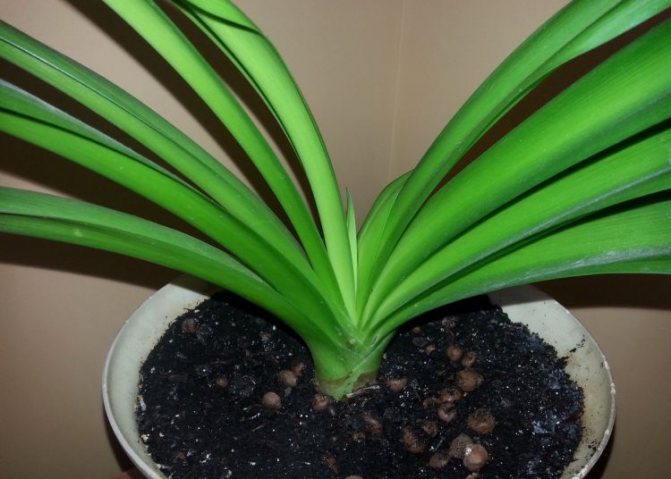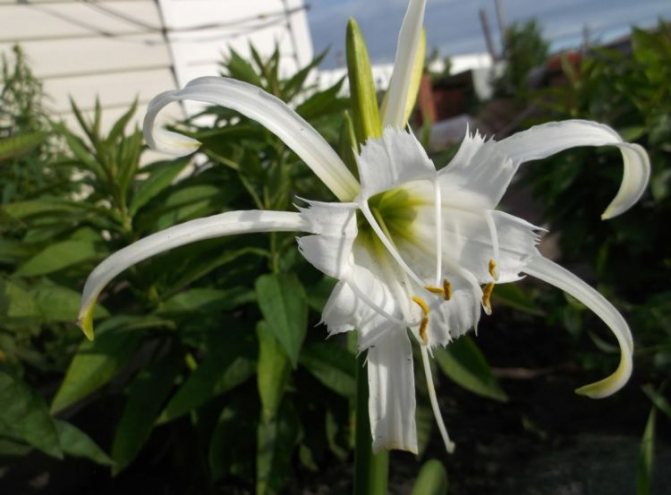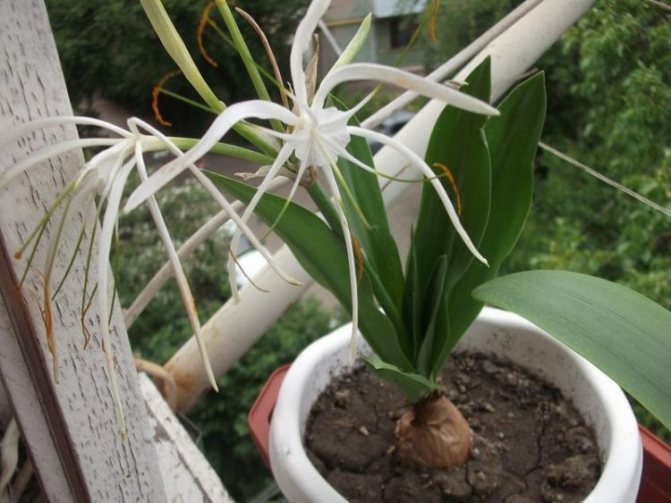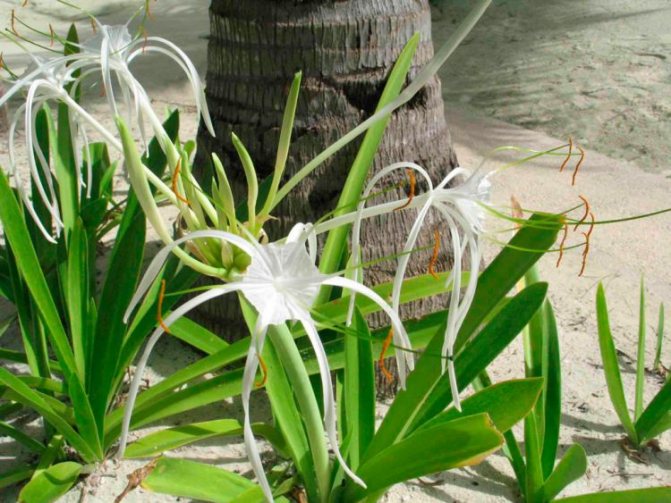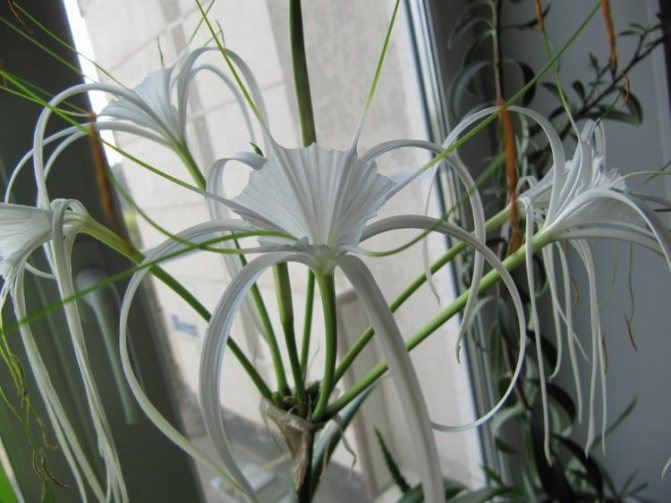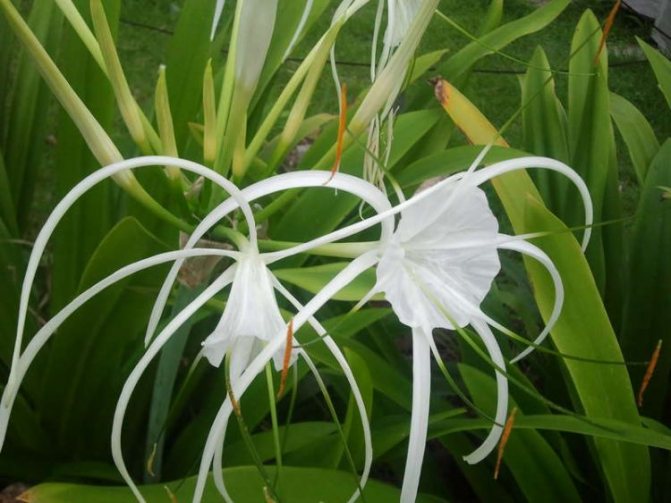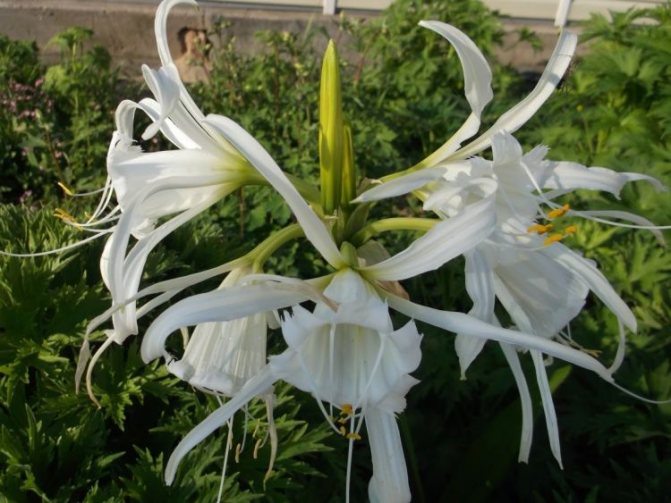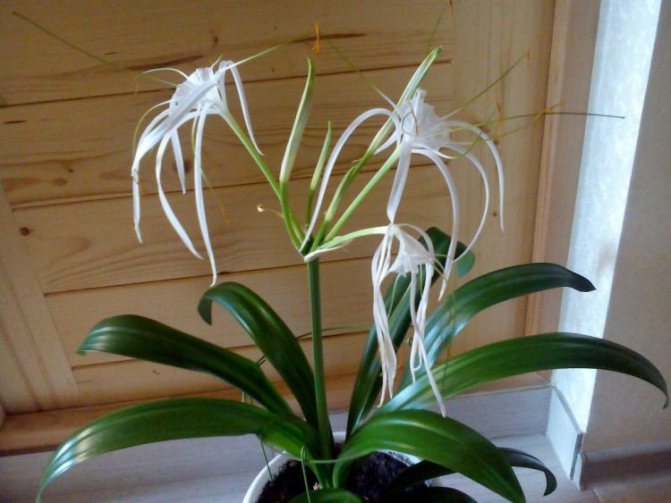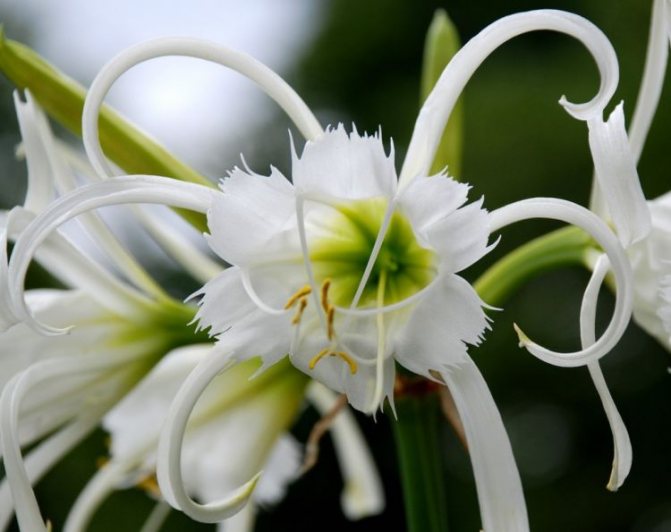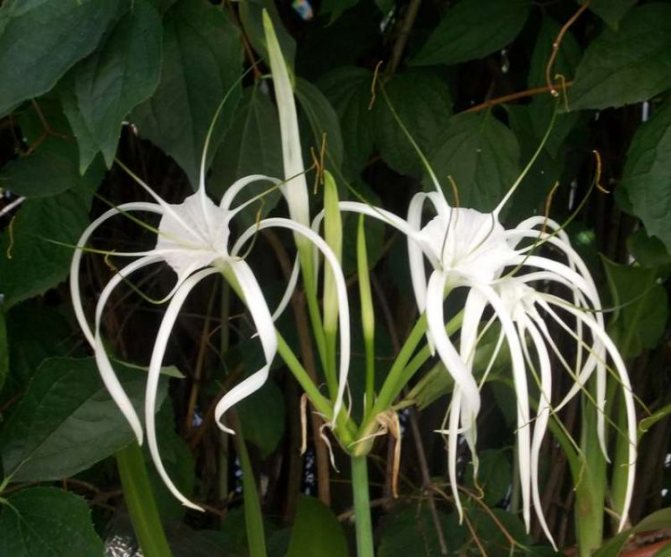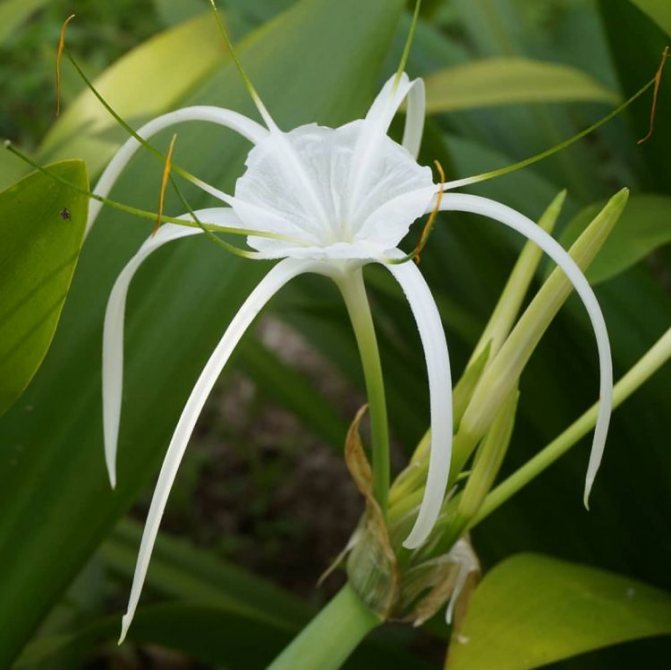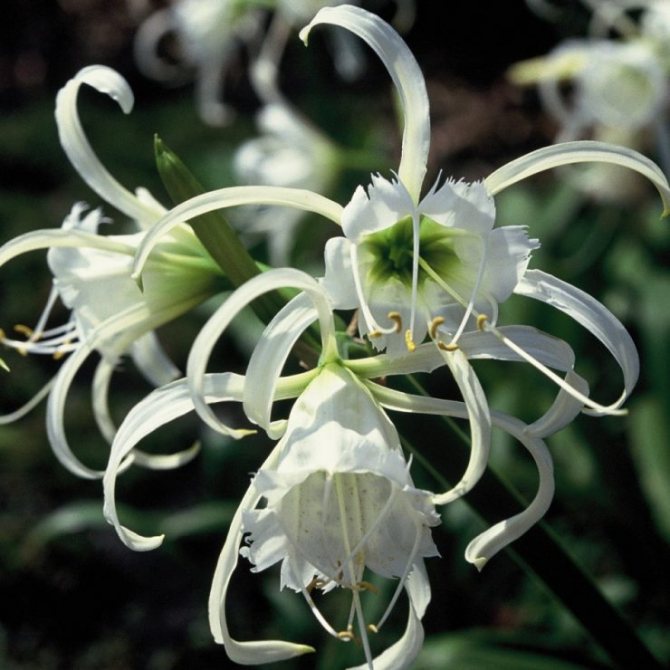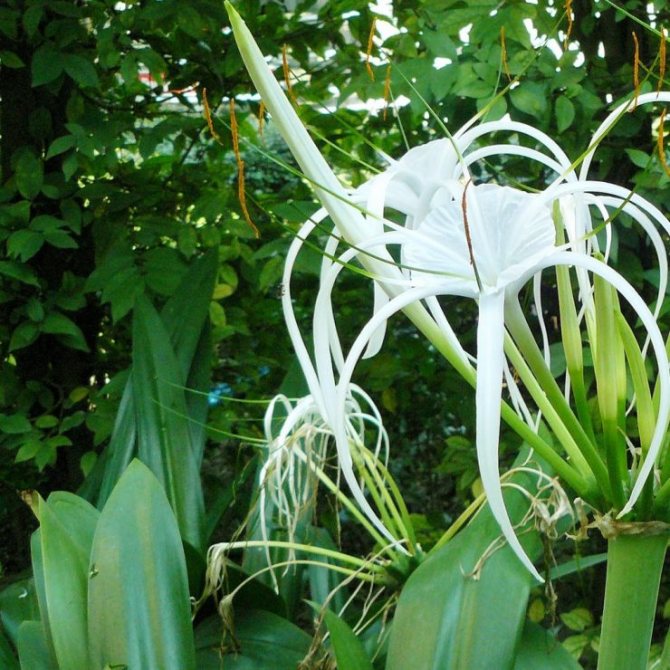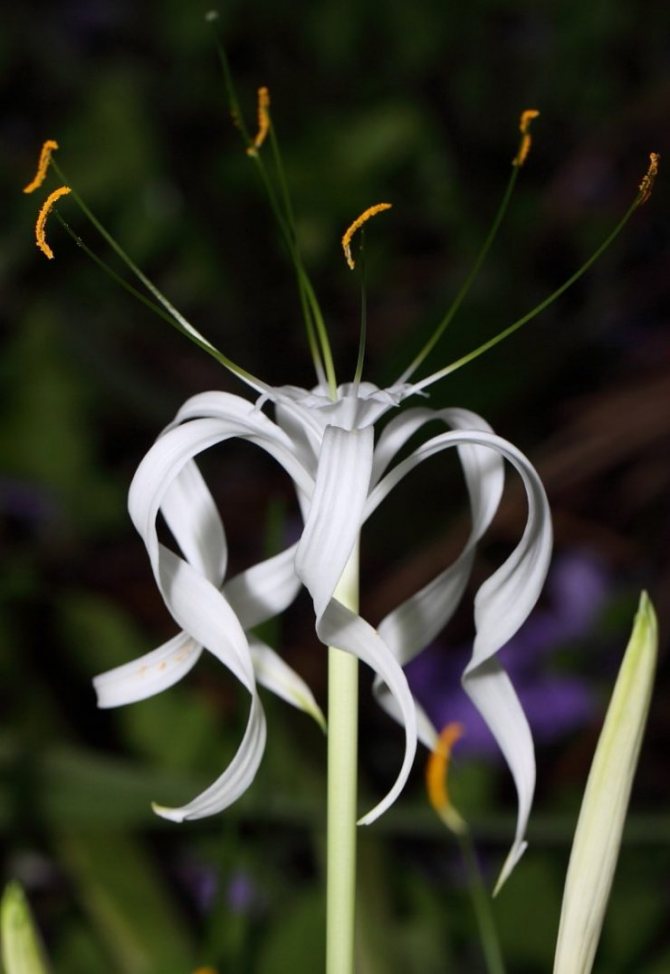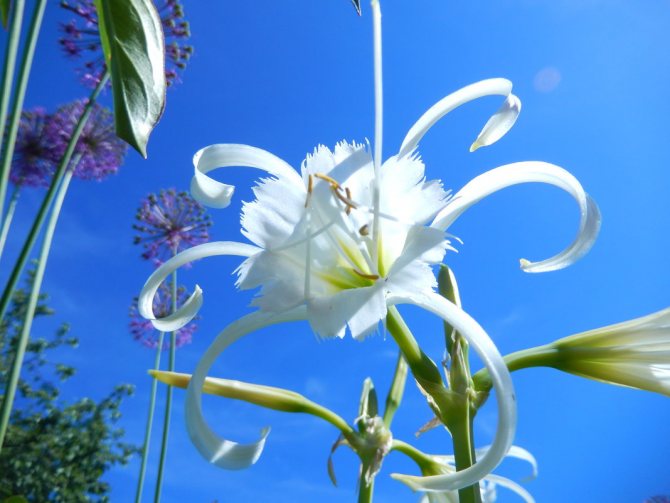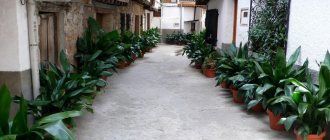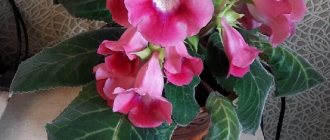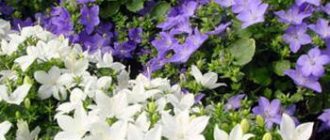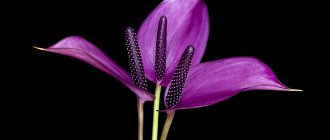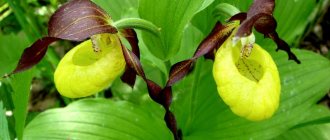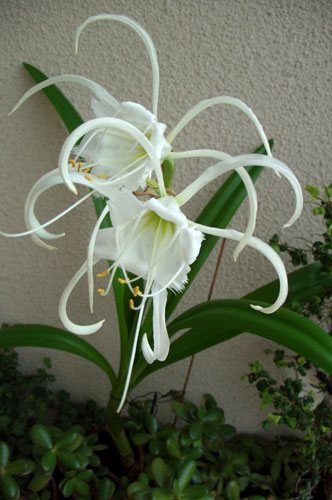
Bulbs early hymenocallis (change of early) in the spring can be found in many stores that have departments for the sale of seeds and other planting material. Several species of this amazing perennial bulbous plant from tropical and subtropical America and the Antilles have recently been grown in the Moscow region. In summer and early change can be grown outdoors. Hymenokallis daffodil (instead of the basket-shaped) can be on the site only in warm summer Other species - hymenokallis beautiful and hymenokallis caribbean - grown only as an indoor culture. Recently hymenocallis hybrids with colored flowers have appeared on the market. The variety "Variegata" with a very decorative leaf color also attracts attention. Be careful, all these plants, like many flowering bulbs, are poisonous.
Alien miracle
Considering a photo of a hymenokallis, even experienced gardeners can not always answer with confidence what kind of flower is in front of them.


Indeed, this bulbous plant of the Amarylis family is not very popular in our area, which is strange, since it has stunningly beautiful inflorescences, as if descended from the pages of science fiction novels.


Ismene and Hymenokallis: so similar, yet different
The first sign of difference is the presence of a pseudostem in the change. It becomes noticeable even in a young plant. Hymenocallis leaves grow in the form of a rosette. At the time of flowering, staminate filaments have a greenish color in Ismen, which is not observed in representatives of hymenocallis.
Flowers in the inflorescence and change are directed to the sides and slightly downward (there is a horizontal deviation of the peduncle from the axis of the peduncle). Everything is different in hymenocallis, since the flowers are directed upwards, the peduncle is a bunch.
For every taste and color
Today in the world there are more than 50 species of exotic plants, but gardeners prefer only a few of them.
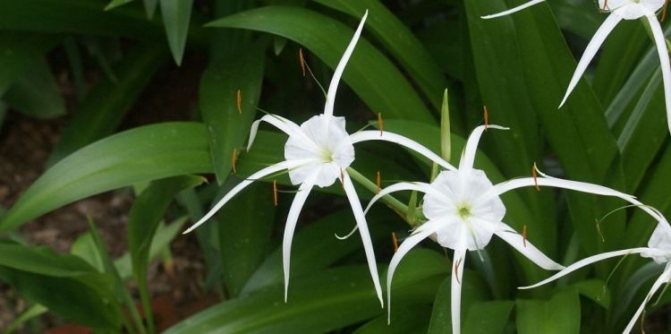

Coastal is an unpretentious and beautiful variety, with long (up to 80 cm) green leaves and fragrant flowers that look like large white spiders. The height of the plant can vary from 30 to 40 cm, while it does not need diligent care.
Read: Alokazia - 105 photos of cultivation, types of plants, care and decoration options with a flower
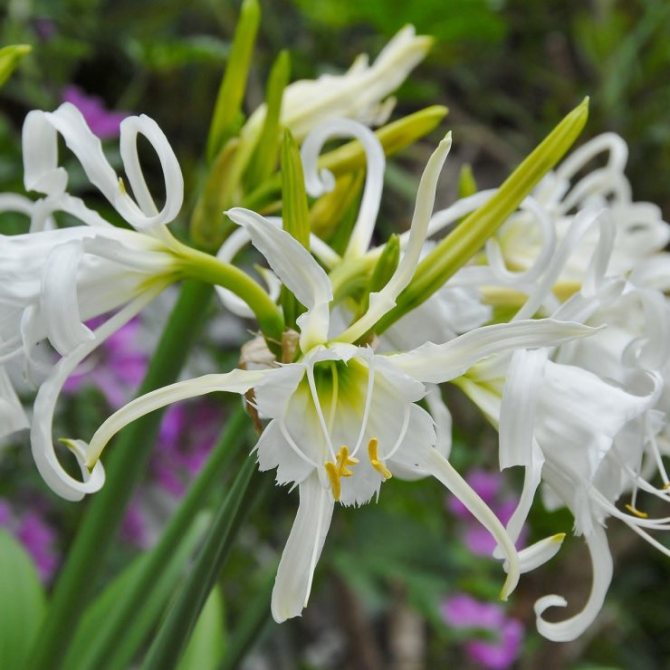

Caribbean is a thermophilic perennial that prefers indoor keeping. White flowers of hymenokallis with bright yellow stamens look very impressive, but so that the plant delights you with beautiful shoots for as long as possible, put a pot with it on a sunny windowsill.
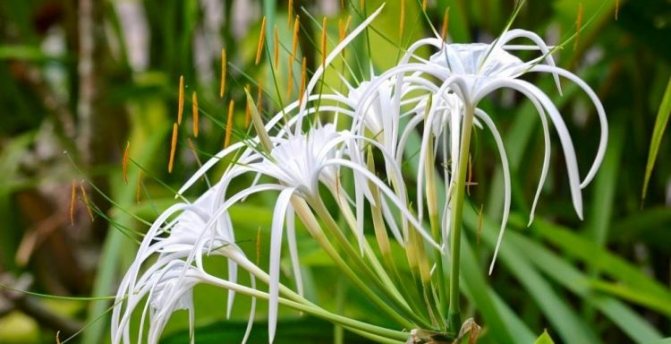

Pleasant (wonderful) - a guest from the subtropics, whose distinctive feature is large, umbrella-shaped flowers, exuding a delicate aroma reminiscent of the smell of lilies. Usually on a powerful peduncle from 6 to 12 such "decorations" are formed.
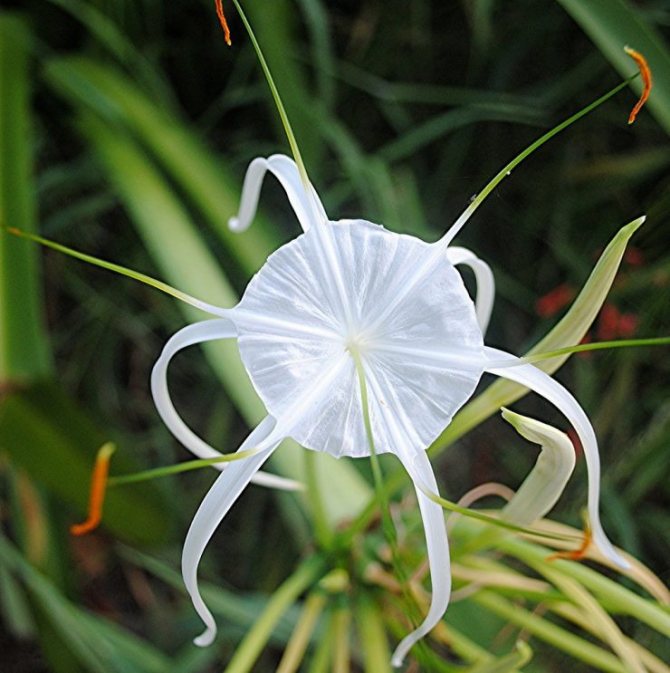

Broadleaf is an ornamental herbaceous crop, whose name speaks for itself. Its distinctive feature is large xiphoid leaves with a clear vein in the center.
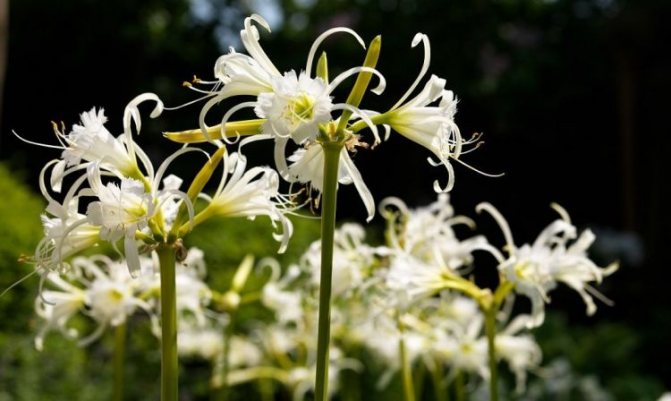

Description of change of hybrid
The first hybrid group is known as Ismena bent, bent (lat.Ismene x deflexa) or in another version typical for Russian-language sources, Ismena festive (lat.Ismene x festalis).
The hybrid was obtained by crossing the long-petalled and daffodil-flowered change (lat.Ismene longipetala + Ismene narcissiflora). It is very popular in indoor and garden floriculture, they call it "Peruvian daffodil" or "spider lily".
Belongs to deciduous bulbous perennials. The egg-shaped bulb is enveloped in a thin layer of light brown scales. Its average diameter is 10-12 cm. Elongated, up to 50-60 cm, dark green leaves with a width of 7 cm to 10 cm form a false erect stem. The formation of this type of stem is very typical for representatives of the isme species.
A single peduncle, glabrous without leaves, up to 40 cm long. On an umbellate inflorescence, from 3 to 6 flowers develop. The perianthus (perianth) at the base looks like a crown due to accrete stamens in the lower part and thin membranes between them. The diameter of the crown is about 5 cm. The crown itself is white, large, with a fringe along the edge.


Ismene festalis planting and care ismene festalis photo in the garden
Additionally, six petals are bent in the form of a spider's leg. Yellow-orange anthers rise above the crown of the flower, which has a pleasant fragrant aroma. This hybrid is the basis for breeding work. A distinctive feature of the new variety Zwanenburg is a rather large bush, the height of which ranges from 80 cm - 90 cm. The flowers, the crown diameter of which reaches 8-10 cm, are large and fragrant. For 2 weeks, bloom is observed and changes in the month of May and June. The flower does not propagate by seeds due to its sterility.
When Ismene narcissiflora and Ismene amancae from Peru were crossed, they formed an interspecific hybrid Sulfur Queen (Latin Ismene hybrids ‘Sulfur Queen’)... He has already gained popularity and went on sale. Its false stem is pronounced. The bush reaches a height of 60 cm. Fragrant flowers are similar to those of a daffodil. The petals are canary-colored, the crown is deep yellow. Green stripes at the bottom of the stamens.
As the flower blooms, its color gradually brightens and at noon it acquires a boiling white color. Only the inner part of the crown near the striped filaments is yellow. For this feature, the hybrid received two more names: Golden Peruvian Daffodil (Latin Golden Peruvian Daffodil) and Sacred Inca Lily (Latin Sacred Inca Lily). In a description of the botanist, of English origin, William Herbert, dated 1837, this interspecific hybrid called Ismene x spofforthiae is found. The name is unofficial, and the hybrid itself was not famous for its popularity.
Much later, when the Van Tubergen brothers founded in Holland in 1868 to sell seeds and bulbs, they began to try to cross different species and change. The result of this experiment is the most beautiful hybrid varieties, including Sulfur Queen, which conquered the whole world.
Breeding features
There are two ways to propagate the indoor plant hymenokallis - bulbous and seed.
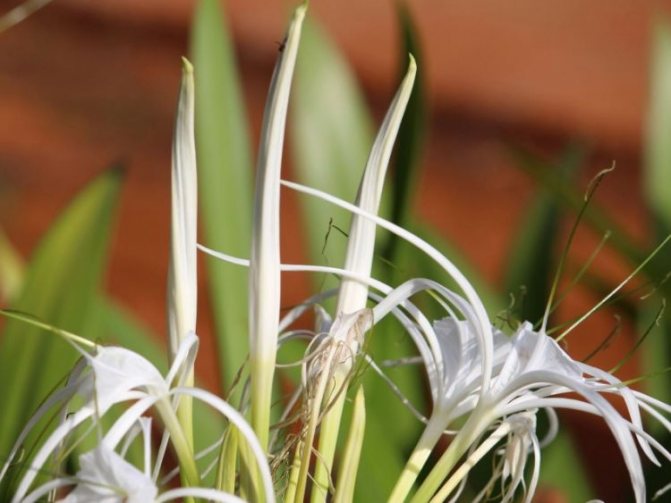

The first is the simplest and fastest. At a plant that has reached the age of 4-5 years, "babies" are formed on the roots. All you have to do is carefully dig up the mother and separate the small bulbs, then transplant them into loose, well-drained soil.
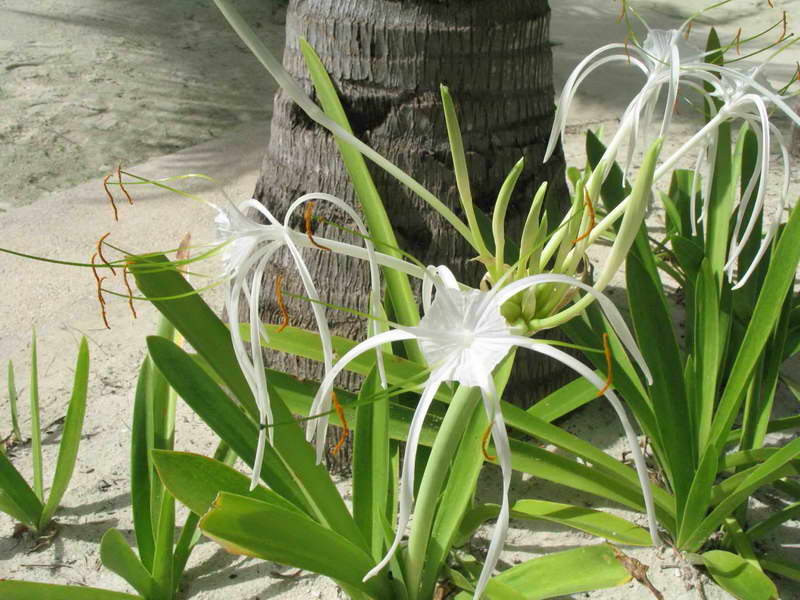

Growing hymenokallis from seeds is a more laborious and time-consuming process. In order for them to germinate, temperature and humidity conditions must be carefully observed.
A mixture of peat and sand is used as the soil, while it must be constantly watered to avoid drying out.
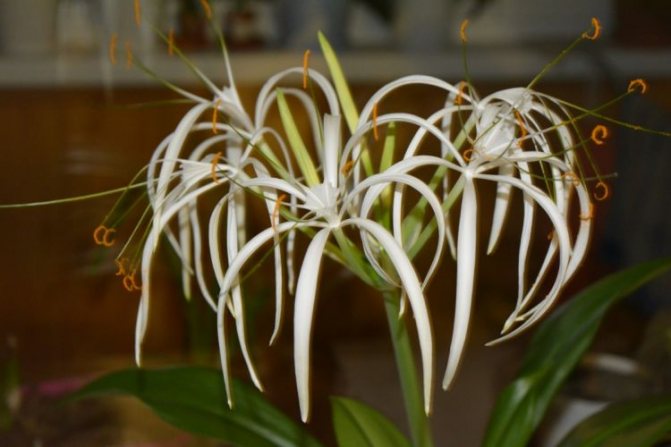

The germination period can take up to 3 months. The first shoots should be protected from direct sunlight - they can burn delicate shoots.
Planting and changing in open ground and storing bulbs in winter
Isme growing and care in the open field and at home Bulbs and photos
During storage of the bulbs, the soil should be dry (limited watering during the dormant period). If the bulbs have been dug out for some reason, then they should be stored in boxes with sawdust.It is not recommended to prune the roots of the bulb during this period. A higher dormant temperature will cause the bulbs to germinate early, which is undesirable. In the land prepared in advance, you need to transplant and change in March. Try not to injure the roots. On the 3rd day after planting, watering of the land is resumed.
If ismena will be cultivated as a garden plant in the open field, you need to prepare the bulbs in advance. To do this, from the end of March, the bulbs are kept in a room in which the temperature is maintained at +18 .. + 20 ° С. The creation of these conditions is necessary in order for the bulbs to independently come out of dormancy and germinate. The compost that has rotted over the winter is added to the soil for planting, and in the first decade of May the flowers are planted.
If the soil for planting is rather dry, then the following actions are taken: the dug hole is heavily moistened, a little sand (dry) or sawdust is poured. An onion is planted in a hole prepared in this way, and it is leveled with a layer of dry earth so that it is 2-3 cm higher from the head of the bulb.
Storage preparation
The peduncle is cut off after flowering. Over the summer, the bulb will grow well. It must be carefully dug out before the onset of autumn frosts.
Even if it is far from frost and the leaves have not yet turned yellow, the end of September is considered the best time to prepare the bulbs for the winter period. They try to preserve the strengthened roots. The newborn babies are not touched until spring, they are left with the mother's bulb. The adhered soil is not strongly shaken off and the tubers are immediately placed on a mesh base (lattice). This is done so that the earth remaining on the roots can crumble. During drying, the leaves will turn yellow and dry on their own.
Two weeks is enough (for drying) to go directly to the storage process. The leaves are trimmed and the bulbs are placed in pots or boxes of dry sawdust.
We create comfortable conditions
Compliance with simple rules will help to grow a well-groomed and lush flower that will delight you with its beauty for more than one year.


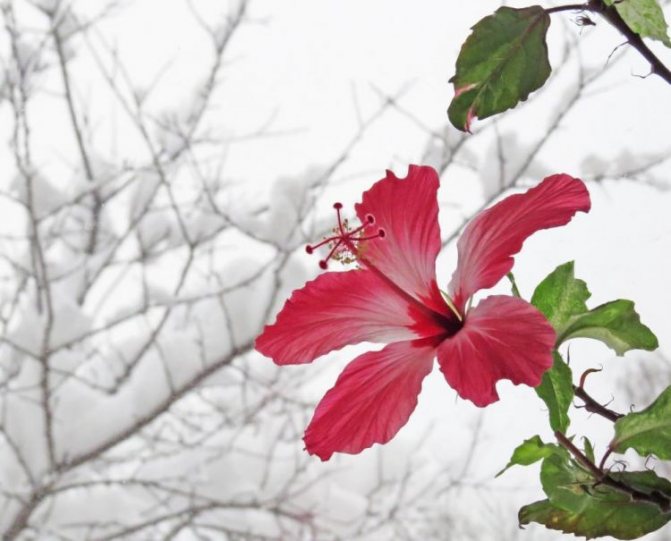

Hibiscus - seedling selection, care, reproduction and advice on watering the plant. 110 photos and video review of the flower

Geranium - secrets of growing, options for use and features of use in decor (95 photos and videos)
- Ahimenes: types, planting, care, reproduction and secrets of use in the garden and in the interior (115 photos)
Care rules
Growing hymenokallis is not difficult. A novice florist can cope with this, although they are afraid to start their hobbies with growing an unusual strange flower. When creating the necessary conditions and observing simple rules for care, the plant will delight with its well-groomed and blooming appearance for a long time.
Lighting
The plant is very fond of light and sun, so you can safely grow it on the south side.
The west and east sides will suit him as well, since some shading will not harm him in the least.
Humidity and temperature
In its natural habitat, hymenokallis is often found on the shores of water bodies. This means that the moisture level is important for the plant for comfortable conditions. If the air at home is dry, then you should think about additional humidification, for example, put a container of water next to the pot or use a humidifier.
During the active growing season, the foliage is sprayed with water, but it is impossible for moisture to get on the buds. The temperature during this period should be in the region of 22-24 ° C.
When the plant begins a dormant period, it is removed to a cool place (10-13 ° C) and not watered. Maintain these conditions for 3 months. This is how long the "hibernation" of the flower lasts.
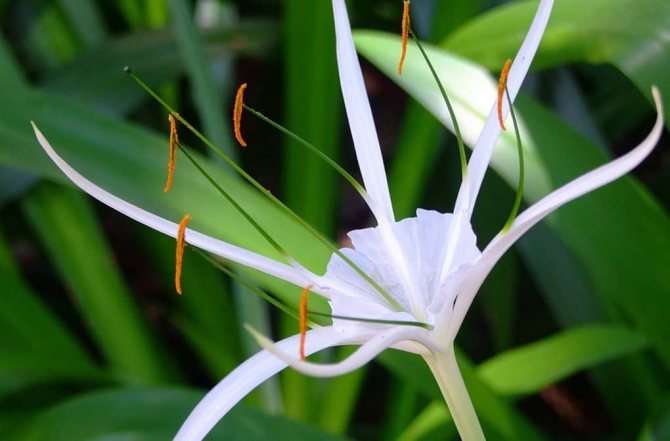

Watering
This perennial bulbous plant requires constant soil moisture. It should not be allowed to dry out, otherwise it will have a detrimental effect on the hymenocallis. Leaves may begin to dry. Overflowing a plant is also harmful. Excessive water levels can cause rotting.
Top dressing
During active growth, hymenokallis should be fed with mineral fertilizers about 1 time in 7-10 days. This will immediately affect flowering. It will be longer and more magnificent. During the rest period, feeding is enough to carry out 1 time.
Transfer
Mature plants should be replanted every 3 or 4 years. The rest period is most suitable for this. For active and lush flowering of hymenokallis, it is worth choosing small pots for it. In cramped conditions, it forms more buds.
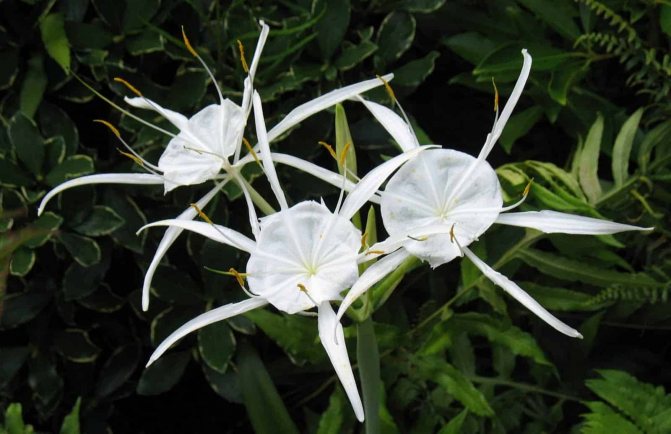

Lighting
When choosing a place for a flowerpot with hymenokallis, remember that it comes from southern countries, so the north side of the house will not suit him.


Do not worry if there is a lot of light on the windowsill - an adult flower is not afraid of direct sunlight.
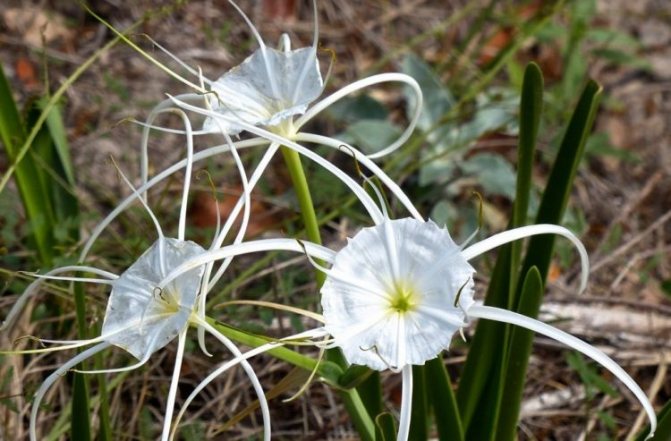

By the way, for species blooming in winter, it is necessary to organize additional lighting - their day should be at least 10-11 hours.
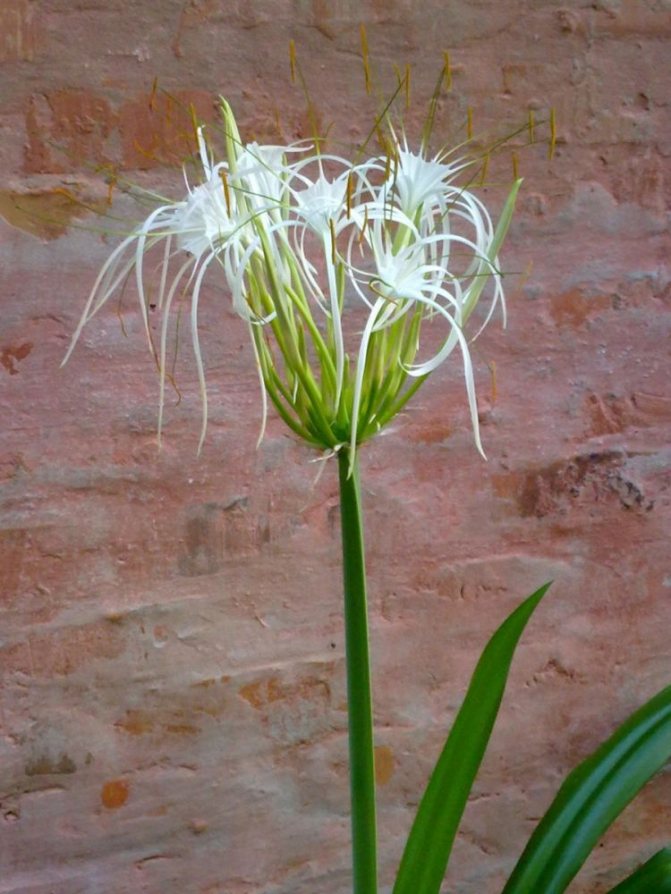

Pest and disease control


Ismena festive ismene festalis photo Ismene x festalis planting and care
- Do not mind whitefly, aphids, scale insects, thrips to settle on the leaves of the plant.
- For those growing indoors, scourges and whiteflies are becoming a scourge. Remove them with an alcohol solution with a cotton swab. Water with such means as confidor or aktara.
- If you water it heavily, or if the flower planted in the garden is influenced by prolonged rainy weather, rot may develop. To avoid this, you need to create conditions so that the soil is not oversaturated with moisture.
Growing in a personal plot
The unpretentiousness of hymenokallis allows you to grow it not only in a flowerpot, but also outdoors.
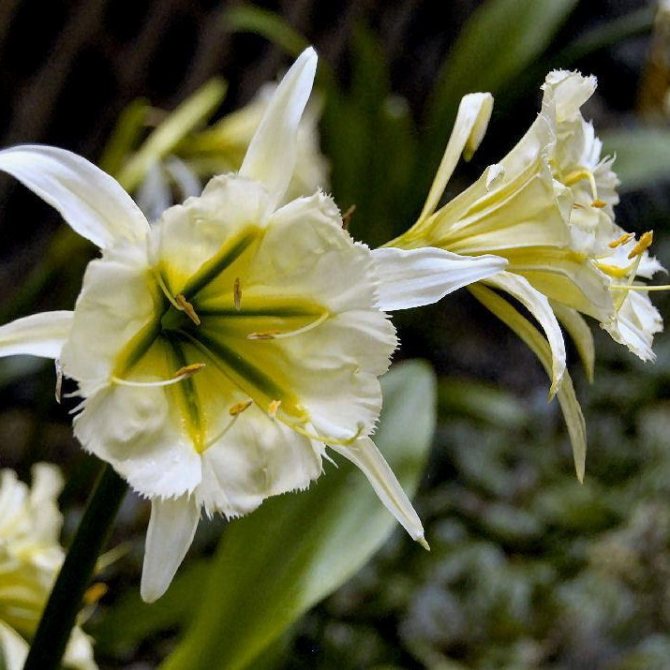

But before planting, the bulb must be germinated in a pot filled with peat and sawdust. Usually, the flower should be moved to the garden in late spring, when the weather is warm.
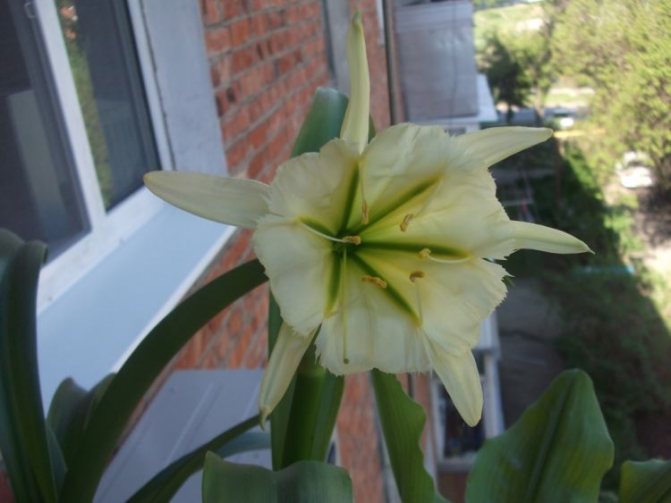

When the plant has faded, dig up the bulb and store it in a cool, dark place. You can plant her again next spring. So the flower will delight you with its unusual beauty for many years.


- Aspidistra - tips for planting, care, reproduction and use in the interior (110 photos and videos)


Washingtonia: species with photos and names, a brief description of the cultivation, useful properties. Detailed instructions on how to care at home
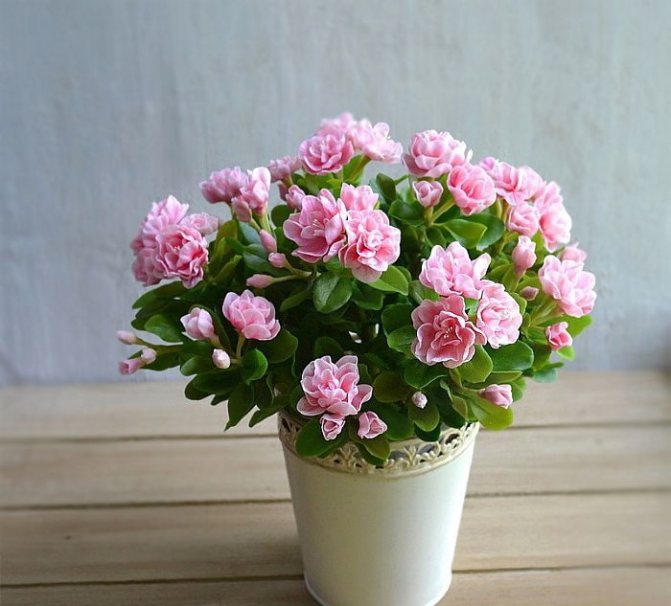

Azalea: description, types and varieties, breeding methods, planting. Rules of care, watering, plant formation, feeding. Diseases and pests. 70 photos of blooming azaleas
How to transplant and change at home and outdoors


How to grow and change indoors. Planting bulbs in a pot
- To transplant a plant, you must first prepare the soil. To do this, take: sod and leafy soil in a ratio of 2: 1, humus and sand in 1 part. Ismene prefers neutral soil. The bottom of a large, 5 or 7-liter pot is covered with a drainage layer of expanded clay or pebbles (provide holes in advance for the drain of excess water). Then - the ground.
- The bulb for transplanting is planted in a pot, sprinkling with soil 3-5 cm.After a while, the onion may become bare, which is undesirable. The way out of this situation is to cover it with fresh soil on top.
If and change is planted in the garden, then it must be remembered that the flower does not like acidic or alkaline soils, or highly moist. Therefore, it is advisable to add compost before planting in the ground. For airiness, sand, bark, straw are brought in - everything that will not retain water in the soil and form a sticky clod of earth. This is necessary to avoid waterlogging. Ismene is a tall flower with a strong and dense green mass that forms during the growing season, thanks to the optimal conditions created for its growth.
Photo of hymenokallis
Did you like the article? Please share with your friends


0
Write a comment
New design
Provence curtains - design ideas and an overview of the ideal combinations of curtains in a rustic style (110 photos and videos)
Minimalism in the apartment - interior ideas and design options. Tips for applying different styles (100 photos)
Kitchen-living room 20 sq. m. - design ideas, interior design options and an overview of the most stylish combinations (110 photos)
Living room decoration - tips for choosing colors and materials. An overview of the most beautiful living room design ideas (90 photos + video)
Bloom
The main decorative value of the hymenokallis is its gorgeous flowers, which have a very unusual shape. Fleshy and tall, up to half a meter, the peduncle is crowned with a long tube, on which the core of the bud is located. It represents fused petals (crown) with a serrated, less often with a smooth edge. Visually, it has the shape of an open umbrella, the "spokes" of which have a continuation in the form of unexpectedly thin and long drooping snow-white petals, bent outward. There are only six of them, while in length they can reach 20 cm. The central stamens are crowned with large round anthers, painted in bright yellow or orange shades.
The buds are collected in inflorescences of an umbrella, less often paniculate type, 2-16 pieces in each. At the end of flowering, oval seeds ripen on the peduncle, which are covered with thick flesh on top.
Common types with photos
There are several types of change:
- coastal view... On a smooth peduncle, an umbrella-shaped inflorescence rises, consisting of white flowers. The strap-like leaves are painted in an emerald hue. The flower consists of six narrow petals, fancifully curving;
- coastal subspecies multicolored. On a strong erect peduncle there are snow-white flowers with a pleasant aroma. The leaves are dark green and belt-shaped. The edges of the leaves are distinguished by wide stripes of gray-white color;
- caribbean view... It is characterized by a round bulb, narrow-lanceolate leaves, tapering towards the base. The umbrella-like inflorescence consists of six to twelve snow-white flowers;
- daffodil look. Leaves of rich green color resemble swords. The flowers are large and yellow.
Types and varieties
Of all the 50 varieties of hymenocallis, the most popular are:
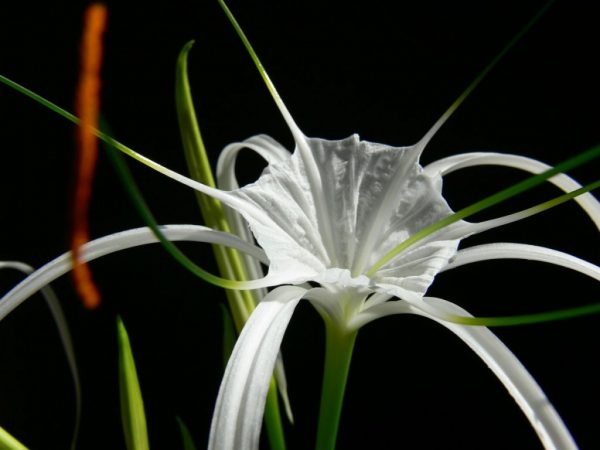

Hymenokallis Caribbean... Brought from Jamaica and the Caribbean. Blooms in autumn and winter for 4 months. The leaves are long (up to 60 cm), the flowers are large.


Hymenokallis early... Originally from Peru. Differs in relatively short narrow leaves. Blooms from April to July.
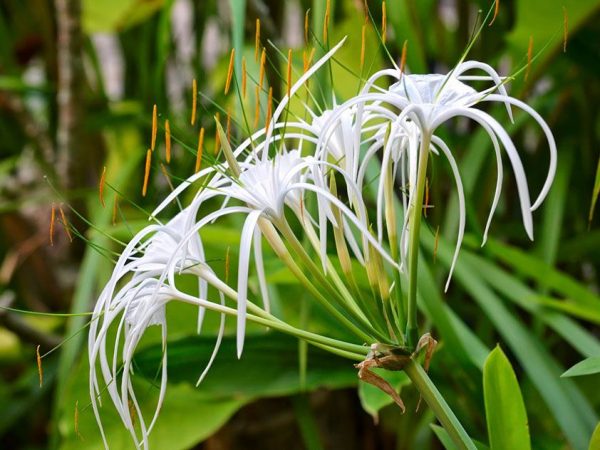

Hymenokallis the beautiful, or pleasant - evergreen look. It grows in the dry areas of the Caribbean. Has a pronounced lily scent.


Hymenokallis broadleaf - a typical representative of the Amaryllis family. Distribution area - Cuba and Jamaica.


Hymenokallis cordifolia differs from all described types. The leaves grow on long stalks and are heart-shaped.


Hymenokallis coastal... Grows in the forest swamps of Latin (Peru, Brazil) and North America (Mexico). Due to its bright colors, it is this species that is most often chosen as a houseplant. Conditions and care
Hymenokallis is an unpretentious houseplant, therefore it does not require special care. The main thing is to observe the watering regime and provide proper lighting.
Spider lily: history and meaning
The spider lily, aka lycoris, came to Europe from East Asia. It got its Latin name in honor of the nereid lycoris from Greek mythology. In China, Thailand, Korea and Japan, it grows in the wild. Local growers do not like lycoris because of its value. It is believed that this red flower grows where blood is shed. It is also considered a symbol of separation, misery.
This is due to a legend based on the following fact: the leaves of a plant die off with the appearance of flowers, and when flowering ends, they grow back. Leaves and flowers, thanks to such a schedule, cannot "meet" each other, like lovers doomed to eternal separation. In addition, it is not uncommon to find a spider lily in cemeteries.


Spider lily
In Russia, there are no such prejudices in relation to licorice: they are considered very original and highly decorative plants, which you can not only admire yourself, but also surprise guests.
In design, the flower goes well with begonias, ferns, anemones and crocuses. The spider lily will give an unusual look to alpine slides and rockeries in combination with irises or delphinium.
It is interesting. In Japan, this plant is called Higanbana, in translation - "the flower of the autumnal equinox." In addition to this name, the Spider Lily has 900 more names, and this is only in Japanese!
Or leaves or flowers
It is a bulbous culture, the flower stalks of which can reach a height of 30 to 70 cm, depending on the variety.
In the spring, the lily has leaves, by the end of summer they dry up, and only in September the flowering period begins - peduncles appear, on which there can be from 3 to 6 flowers, the flowering time lasts from 3 to 4 weeks. You will never find a lycoris on which there would be leaves and flowers at the same time - this is a feature of this plant.
RARE PLANT SEEDS FOR YOUR GARDEN - FREE SHIPPING. PRICES ARE VERY LOW. THERE ARE REVIEWS


Varietal variety
Lily Pretty Wumen
There are two dozen varieties of lycoris known to science. But only a few are grown on the territory of Russia:
- Licoris blood-red. A real red miracle, surprising not only with the original shape of the petals, but also with their bright color, in honor of which the flower got its name. It grows up to 45 cm in height. Up to 6 buds grow on one peduncle. Blooms in August.
- Scaly licorice. Its flowers are larger. On a peduncle, 70 cm high, there can be up to 9 of them. The graceful petals of the plant are painted in a pale lilac color, with a golden center.
- Licoris radiant. Has a second name - mustachioed, obtained due to the similarity of the lateral petals with antennae. The central petals also have an unusual, wavy shape.
- Licoris golden. In fact, it is a type of radiant lycoris. Also highly decorative. The petals, according to the name, are golden in color.
Important! Some varieties do not produce seeds and are sterile. Their planting is possible only in a vegetative way, that is, with baby bulbs.
Possible growing problems
The plant has weak immunity and resistance to pest infestation. The greatest danger to the flower is aphid, scale insect and thrips. In the early stages of infection, they can be removed with a cotton pad dipped in soapy water.
In case of severe damage to the plant, a chemical insecticide should be used, for example, Aktara, Actellik or Confidor.
In conditions of high humidity, there is a possibility of rotting of the bulbs. To avoid this, you should regularly loosen the soil surface and control the irrigation regime.
The problem can be identified by a decrease in the growth rate, the appearance of soft and dark spots on the stem.
When you look at the unusual, unearthly beauty of Ismena flowers, it seems as if this plant was miraculously brought from another planet. Indeed, there is something cosmic in him. And yet this is a bulbous plant of terrestrial origin, just Mother Nature endowed it with original, rare, boiling white, vanilla-scented inflorescences, hence the various names: Spider Lily, Peruvian Narcissus, Membrane Flower. So what is this plant - Ismena?
Description and characteristics
This extraordinary perennial plant belongs to the amaryllis family.Therefore, some of its varieties are called Golden Amaryllis.
Lily Epricot Fudge
The bright green leaves of lycoris, which have a belt-like shape, reach 30-40 cm in length and up to 2 cm in width. They appear in the spring from the bulbs of the plant. The latter are distinguished by their special thermophilicity and small, up to 5 cm, size.
In the middle of summer, when the leaves die off, a fleshy, round stem emerges from the bulb. It stretches in height by about 70 cm, after which inflorescences begin to appear at its top. The number of flowers on one stem varies from 4 to 7 pieces.
Large buds of Spider Lily bloom only by September, filling the space around them with a strong, pleasant aroma.
The petals, as the name implies, are like lilies. And the stamens resemble thin cobwebs. Their color depends on the variety, white, scarlet, purple, golden, red colors are possible.
Spider lily blooms for a short time, only 1.5 - 2 weeks. Some varieties take about 30 days. After that, boxes with small black seeds appear on the plant. After the peduncle has completely wilted, leaves appear from under the ground again. They will survive until the next summer bloom.
Important! Lycoris, especially its bulbs, contains a dangerous substance - lycorin. Therefore, all work with him is carried out exclusively with gloves! Bulbs and other parts of the plant must not be eaten or given to children or animals.
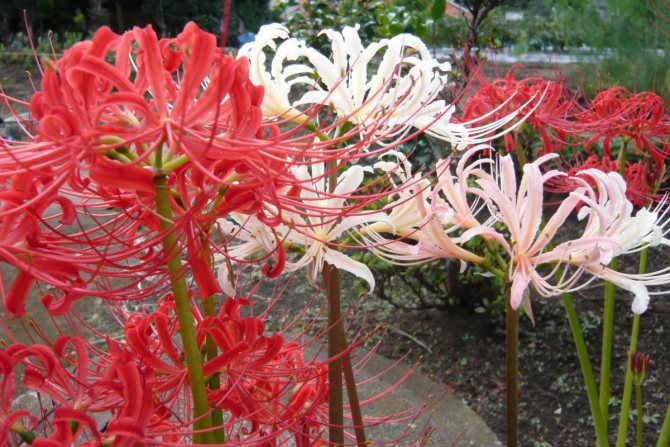

Spider lily flowers
Where to buy nerine
The flower can be purchased at flower markets, specialty stores, or through an online order.
A nerine bulb will cost about 160 rubles per piece.
Seedlings ordered via the Internet can be sent by mail, but only in the spring. The cost of one seedling will be about 130 rubles.
Seeds will be difficult to find, and the price is high. A package of 5 seeds can be purchased at a price of 340 rubles.
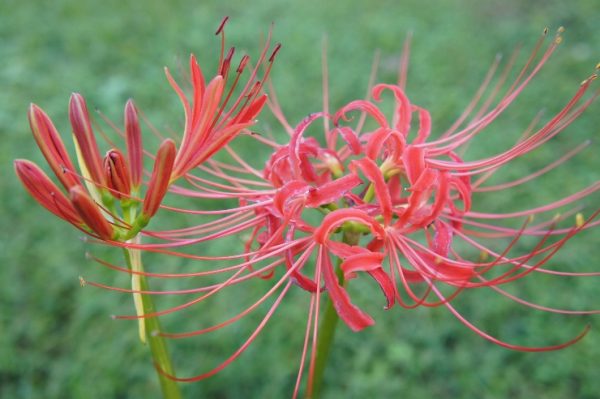

A flower from tropical countries will decorate a room or office.
The exotic Nerine flower with unusual petals will become the pride and decoration of the collection for professional florists or amateurs. The rapid growth and development of a plant depends on proper care. It is important not to miss the moments of the flower's transition to periods of rest and return to active life and flowering.
And my lily Spider blossomed in the open ground at the dacha (Naro-Fominsk district of the Moscow region). Survived all night cold snaps! Tell me how to save lilies for the next season!
Possible diseases
The constant moisture of the soil attracts many parasites, this is a spider mite or aphid, so insecticide treatment is needed, especially in the garden.
If the plant is sick with a red burn or gray rot, this part of the bulb is enough to cut off. Then treat with foundation or sprinkle with ash.
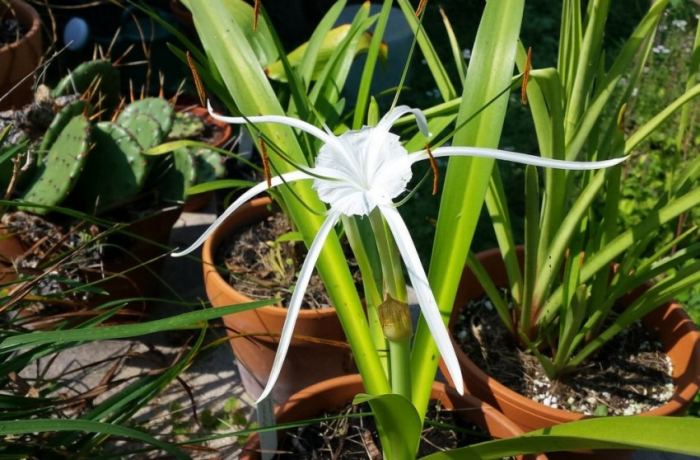

Brown spots on the leaves - possibly anthracnose Hymenokallis, then the affected leaves are cut off and burned.
A beautiful plant with snow-white spider flowers needs to be well moistened, but not flooded. Provide access to fresh air, loosen the soil well. If the plant is in the garden, maintain a distance between the bushes. If you follow the listed conditions, the luxurious hymenokallis flowers will delight their owners for a long time.
How to care for a Peruvian daffodil
There is nothing difficult in caring for a change. In order for the flower to feel good and delight in lush color, it is enough to perform the following work:
- Watering. It is important to find a middle ground here. With a lack of moisture, the leaves will wither, and with an excess, they will begin to turn yellow. In addition, when wet, the bulbs quickly rot. Arrangement when planting good drainage will help to avoid such incidents.
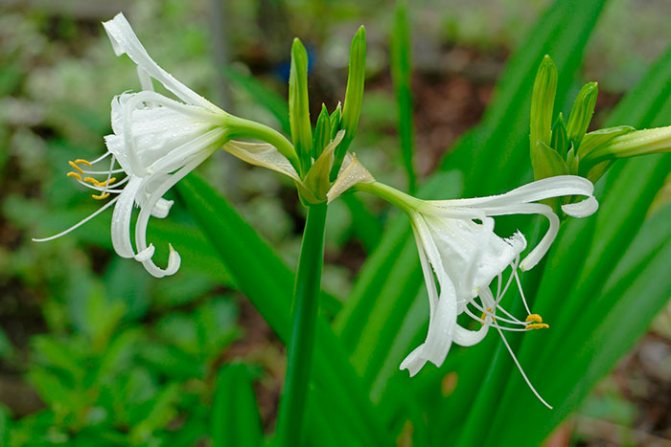

- Pruning. Peduncles on large bulbs appear in June. The fragrant flowers open in turn, allowing continuous flowering and change over a couple of weeks. Immediately after the buds wither, the peduncles are cut off.
- Top dressing.The first fertilizer in the form of humus is applied when planting the bulbs. Then every 3 weeks the flower is fed with a complex of minerals.
- The bulbs are dug up in September. In this case, you do not need to wait for the yellowing of the leaves. Plants taken from the ground are completely laid out on a grid for long-term drying. Dried leaves are gradually cut off. The roots are not touched.
- After removing all the leaves, the bulbs are stored in a dry, cool place, such as a basement.
- The next spring, the planting material is removed from storage and planted again in the garden.
Ismena is a very interesting and unusual looking flower. Having planted a bulb, with a minimum of effort and spending very little time, such beauty can be observed every season in your own garden.

